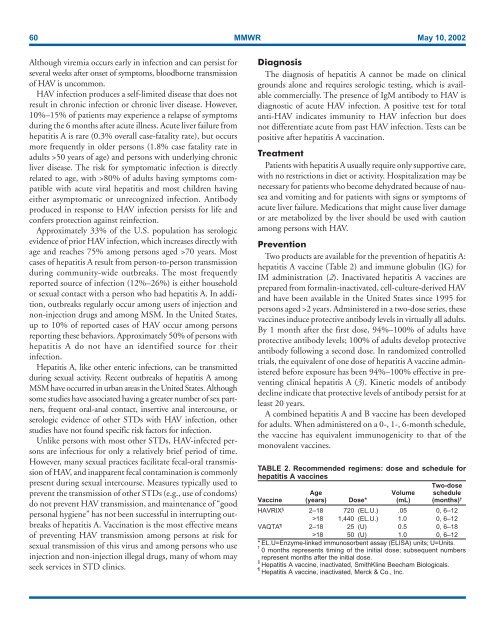You also want an ePaper? Increase the reach of your titles
YUMPU automatically turns print PDFs into web optimized ePapers that Google loves.
60 MMWR May 10, 2002<br />
Although viremia occurs early in infection and can persist for<br />
several weeks after onset of symptoms, bloodborne transmission<br />
of HAV is uncommon.<br />
HAV infection produces a self-limited disease that does not<br />
result in chronic infection or chronic liver disease. However,<br />
10%–15% of patients may experience a relapse of symptoms<br />
during the 6 months after acute illness. Acute liver failure from<br />
hepatitis A is rare (0.3% overall case-fatality rate), but occurs<br />
more frequently in older persons (1.8% case fatality rate in<br />
adults >50 years of age) and persons with underlying chronic<br />
liver disease. The risk for symptomatic infection is directly<br />
related to age, with >80% of adults having symptoms compatible<br />
with acute viral hepatitis and most children having<br />
either asymptomatic or unrecognized infection. Antibody<br />
produced in response to HAV infection persists for life and<br />
confers protection against reinfection.<br />
Approximately 33% of the U.S. population has serologic<br />
evidence of prior HAV infection, which increases directly with<br />
age and reaches 75% among persons aged >70 years. Most<br />
cases of hepatitis A result from person-to-person transmission<br />
during community-wide outbreaks. The most frequently<br />
reported source of infection (12%–26%) is either household<br />
or sexual contact with a person who had hepatitis A. In addition,<br />
outbreaks regularly occur among users of injection and<br />
non-injection drugs and among MSM. In the United States,<br />
up to 10% of reported cases of HAV occur among persons<br />
reporting these behaviors. Approximately 50% of persons with<br />
hepatitis A do not have an identified source for their<br />
infection.<br />
Hepatitis A, like other enteric infections, can be transmitted<br />
during sexual activity. Recent outbreaks of hepatitis A among<br />
MSM have occurred in urban areas in the United States. Although<br />
some studies have associated having a greater number of sex partners,<br />
frequent oral-anal contact, insertive anal intercourse, or<br />
serologic evidence of other STDs with HAV infection, other<br />
studies have not found specific risk factors for infection.<br />
U<strong>nl</strong>ike persons with most other STDs, HAV-infected persons<br />
are infectious for o<strong>nl</strong>y a relatively brief period of time.<br />
However, many sexual practices facilitate fecal-oral transmission<br />
of HAV, and inapparent fecal contamination is commo<strong>nl</strong>y<br />
present during sexual intercourse. Measures typically used to<br />
prevent the transmission of other STDs (e.g., use of condoms)<br />
do not prevent HAV transmission, and maintenance of “good<br />
personal hygiene” has not been successful in interrupting outbreaks<br />
of hepatitis A. Vaccination is the most effective means<br />
of preventing HAV transmission among persons at risk for<br />
sexual transmission of this virus and among persons who use<br />
injection and non-injection illegal drugs, many of whom may<br />
seek services in STD clinics.<br />
Diagnosis<br />
The diagnosis of hepatitis A cannot be made on clinical<br />
grounds alone and requires serologic testing, which is available<br />
commercially. The presence of IgM antibody to HAV is<br />
diagnostic of acute HAV infection. A positive test for total<br />
anti-HAV indicates immunity to HAV infection but does<br />
not differentiate acute from past HAV infection. Tests can be<br />
positive after hepatitis A vaccination.<br />
Treatment<br />
Patients with hepatitis A usually require o<strong>nl</strong>y supportive care,<br />
with no restrictions in diet or activity. Hospitalization may be<br />
necessary for patients who become dehydrated because of nausea<br />
and vomiting and for patients with signs or symptoms of<br />
acute liver failure. Medications that might cause liver damage<br />
or are metabolized by the liver should be used with caution<br />
among persons with HAV.<br />
Prevention<br />
Two products are available for the prevention of hepatitis A:<br />
hepatitis A vaccine (Table 2) and immune globulin (IG) for<br />
IM administration (2). Inactivated hepatitis A vaccines are<br />
prepared from formalin-inactivated, cell-culture-derived HAV<br />
and have been available in the United States since 1995 for<br />
persons aged >2 years. Administered in a two-dose series, these<br />
vaccines induce protective antibody levels in virtually all adults.<br />
By 1 month after the first dose, 94%–100% of adults have<br />
protective antibody levels; 100% of adults develop protective<br />
antibody following a second dose. In randomized controlled<br />
trials, the equivalent of one dose of hepatitis A vaccine administered<br />
before exposure has been 94%–100% effective in preventing<br />
clinical hepatitis A (3). Kinetic models of antibody<br />
decline indicate that protective levels of antibody persist for at<br />
least 20 years.<br />
A combined hepatitis A and B vaccine has been developed<br />
for adults. When administered on a 0-, 1-, 6-month schedule,<br />
the vaccine has equivalent immunogenicity to that of the<br />
monovalent vaccines.<br />
TABLE 2. Recommended regimens: dose and schedule for<br />
hepatitis A vaccines<br />
Two-dose<br />
Age Volume schedule<br />
Vaccine (years) Dose* (mL) (months) †<br />
HAVRIX § 2–18 720 (EL.U.) .05 0, 6–12<br />
>18 1,440 (EL.U.) 1.0 0, 6–12<br />
VAQTA ¶ 2–18 25 (U) 0.5 0, 6–18<br />
>18 50 (U) 1.0 0, 6–12<br />
* EL.U=Enzyme-linked immunosorbent assay (ELISA) units; U=Units.<br />
†<br />
0 months represents timing of the initial dose; subsequent numbers<br />
represent months after the initial dose.<br />
§<br />
Hepatitis A vaccine, inactivated, SmithKline Beecham Biologicals.<br />
¶<br />
Hepatitis A vaccine, inactivated, Merck & Co., Inc.


